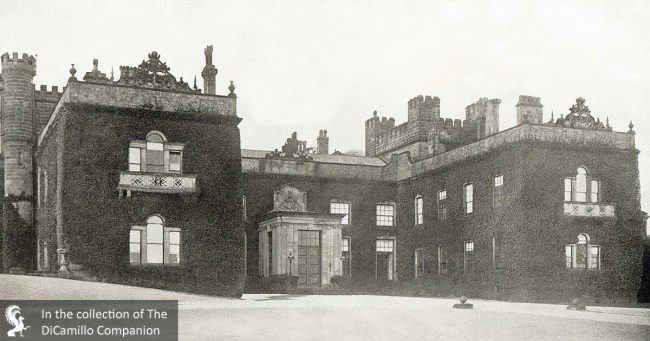
The house from "Morris's Views of Seats," circa 1875.

The house from a circa 1912 photograph

The house from a 1909 postcard

The temple from a circa 1910 postcard

In this famous conversation piece, Sir Lawrence Dundas is shown in one of the Robert Adam-designed rooms of his London townhouse, 19 Arlington Street. Purchased by Sir Lawrence in 1763 for £15,000, 19 Arlington remained the Dundas family’s London home until it was demolished in 1936 and replaced by an apartment building.

The 1764 Robert Adam-designed vermeil Richmond Race Cup, today in the collection of the Museum of Fine Arts, Boston.
House & Family History: Aske Hall was sold by the 4th Earl of Holderness to Sir Lawrence Dundas, 1st Bt., in 1763 for £45,000 (approximately £78 million in 2016 values using the labour value commodity index) and the estate has remained in the hands of his descendants ever since. Sir Lawrence had a spectacularly successful career. The second son of Thomas Dundas, a draper from Perthshire, Lawrence began his professional life as a modestly successful wine merchant. He hit the big time in the 1750s, when he was appointed commissary general to the forces during the Seven Years' War. This position, in which he supplied goods to the British Army, enabled Lawrence to amass a great fortune, which he used to become a successful banker and Whig politician. Made a baronet in 1762, Sir Lawrence used his great wealth to buy houses and estates in England, Scotland, and Ireland. A member of the Society of Dilettanti, and a man of great taste, he formed large and important art collections at his houses and commissioned furniture and fittings from the finest makers of the day, including Thomas Chippendale, John Cobb, and William Vile (see “Images” section for Zoffany painting of Sir Lawrence and his grandson in his London townhouse). At his death in 1781, Sir Lawrence left his son an immense fortune of £900,000 (over £1 billion in 2019 inflation-adjusted values using the labour value commodity index). Sir Lawrence is buried in the Dundas Mausoleum at Falkirk Old Parish Church.
Collections: Aske contains paintings by Gainsborough and Raeburn and important pieces of Meissen porcelain and Chippendale furniture. The house is also home to a fine pair of French style marquetry commodes made by Pierre Langlois, a Huguenot cabinetmaker who worked in London in the mid-18th century. Like much in the collection at Aske, these commodes were purchased by Sir Lawrence Dundas for either his London townhouse, 19 Arlington Street, or his Hertfordshire country house, Moor Park. Aske also contains a fireplace that was removed from Clumber Park. The 4th Marquess of Zetland sold a Roman sculpture from Aske Hall for more than $19 million in New York City in December of 2011.
Garden & Outbuildings: Capability Brown designed the parkland and the bridge. Richmond has one of the earliest documented racecourses in England and played an important role in the popularity of horseracing in Britain in the 18th century. A large share of the credit for this goes to Sir Lawrence Dundas, the 1st Baronet, who purchased Aske in 1763 and ran the first Richmond Gold Cup on the grounds of his estate, near Richmond, in September 1764, thus beginning one of the great Georgian flat races. Dundas engaged his architect, Robert Adam, to design the winner's cup, considered by many to be the first piece of Neoclassical silver ever made (Adam's design for this cup became the standard for all subsequent race trophies. The original sketch for the cup is today in the collection of Sir John Soane's Museum, London). The winner's cup was made in vermeil by the London goldsmiths Daniel Smith and Robert Sharp and appears to have been given to the winner each year between 1764 and 1770. The first of these, hallmarked 1764 and awarded to John Hutton, was sold in 1987 for £66,000 to the Museum of Fine Arts, Boston, in whose collection it remains today (see photo in "Images" section).
Chapel & Church: John Carr designed the stableblock in 1765, which was later converted into the chapel.
Architect: William Kent
Date: Circa 1735Architect: Daniel Garrett
Date: 1750sArchitect: John Carr
Date: Circa 1765-69Architect: Ignatius Bonomi
Date: Circa 1840 onwardArchitect: Claud Phillimore
Date: 1963-64Country Life: Giles Worsley in Mar 8, 1990 issue.
Title: Biographical Dictionary of British Architects, 1600-1840, A - HARDBACK
Author: Colvin, Howard
Year Published: 2008
Reference: pgs. 139, 168, 226, 411, 617
Publisher: New Haven: Yale University Press
ISBN: 9780300125085
Book Type: Hardback
Title: Debrett's Peerage and Baronetage, 1990
Author: Kidd, Charles; Williamson, David (Editors)
Year Published: 1990
Reference: pg. P 1296
Publisher: London: Debrett's Peerage Limited (New York: St. Martin's Press, Inc.)
ISBN: 0312046405
Book Type: Hardback
House Listed: Grade I
Park Listed: Grade II*
Current Seat / Home of: Lawrence Mark Dundas, 4th Marquess of Zetland; Dundas family here since 1763.
Past Seat / Home of: Aske family, 15th century. Robert Bowes, 16th century. Wharton family, 17th century. Sir Conyers Darcy (Darcey or D'Arcy), until 1758; Robert Darcy, 4th Earl of Holderness, 1758-63. Sir Lawrence Dundas, 1st Bt., 1763-81; Sir Thomas Dundas, 1st Baron Dundas and 2nd Bt., 1781-1820; Lawrence Dundas, 1st Earl of Zetland and 2nd Baron Dundas, 1820-39; Thomas Dundas, 2nd Earl of Zetland, 1839-73; Lawrence Dundas, 1st Marquess of Zetland and 3rd Earl of Zetland, 1873-1929; Lawrence John Lumley Dundas, 2nd Marquess of Zetland, 1929-61; Lawrence Aldred Mervyn Dundas, 3rd Marquess of Zetland, 1961-89.
Current Ownership Type: Individual / Family Trust
Primary Current Ownership Use: Private Home
House Open to Public: Limited Access
Phone: 01748-822-000
Fax: 01748-823-252
Email: [email protected]
Website: https://www.zetland.co.uk/
Historic Houses Member: No